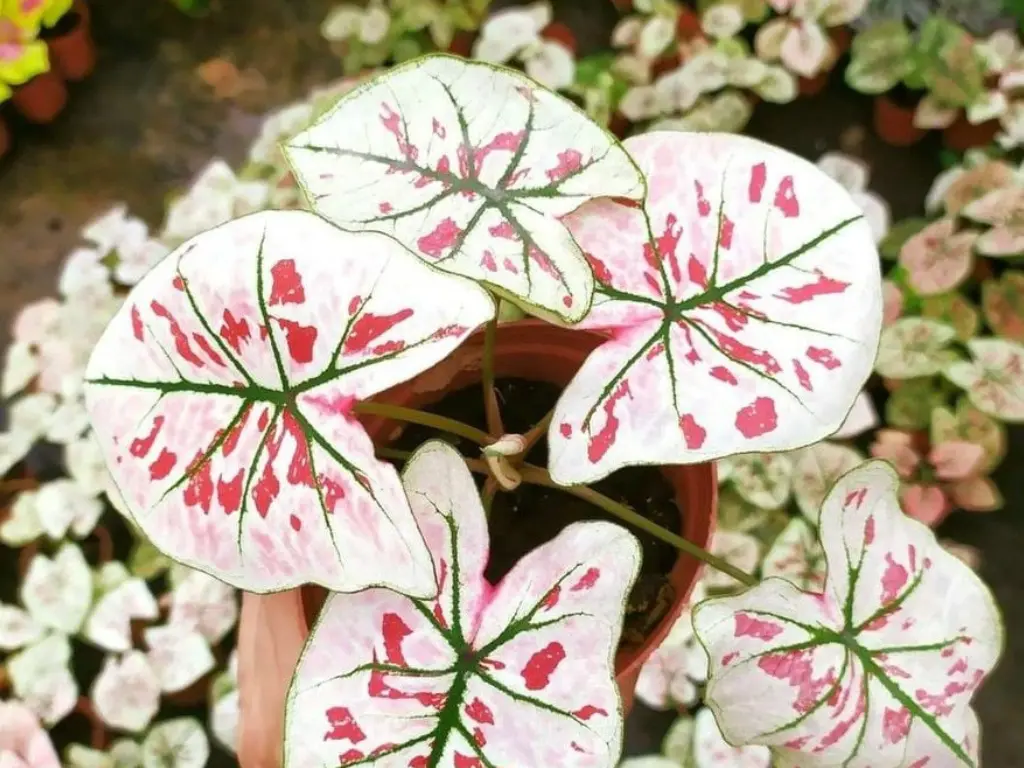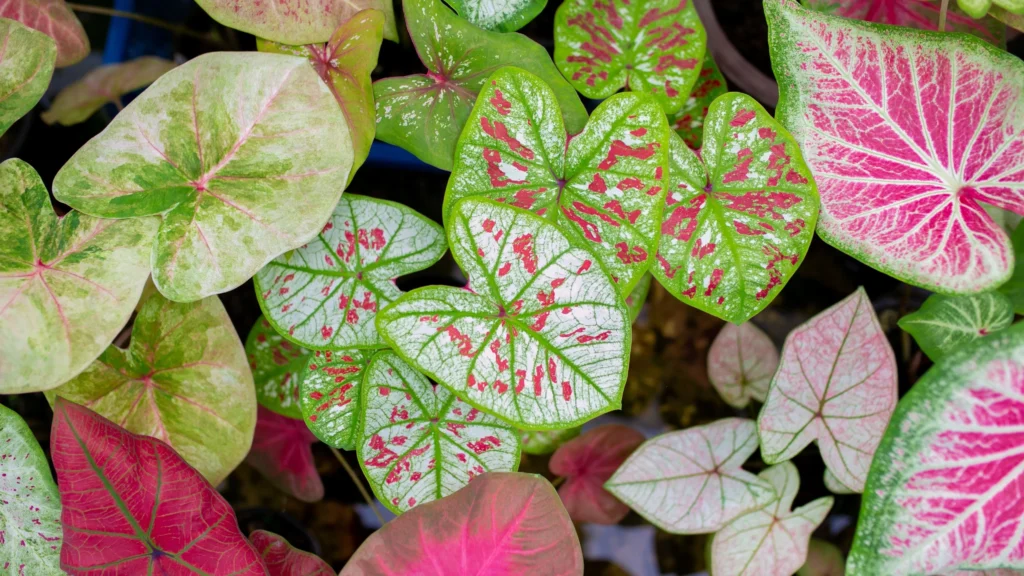Bring a burst of tropical color to your home or garden with these gorgeous, low-maintenance foliage plants. Caladiums are known for their bold, heart-shaped leaves and vibrant variegation in pinks, reds, whites, and greens. Whether you’re styling a shady patio corner or refreshing your indoor plant shelf, these showstoppers will add personality and warmth with minimal effort.
From compact varieties perfect for pots to bold types that thrive in garden beds, Caladiums are surprisingly versatile. In this post, I’m walking you through the top 5 most colorful Caladium varieties and giving you a real-world, easy-to-follow care guide to help them thrive, whether you live in Florida or anywhere in the U.S. where indoor gardening is your thing.
Let’s be honest—while most houseplants add greenery, not all of them bring drama. Caladiums, on the other hand, are a colorful punch to any dull space. With their heart-shaped leaves and vivid splashes of pink, red, white, and green, they’re like nature’s artwork in plant form.
What makes them even better is how easy they are to grow. Fancy-leaf Caladiums come in eye-catching patterns that look great without needing bright sunlight. In fact, they prefer shade or filtered light, making them perfect for porches, shaded garden beds, or even office corners. These tropical plants grow from bulbs—or technically tubers—and in warmer zones, they’ll return each year like clockwork. In colder climates, you can store the tubers and replant them in spring.
Top 5 Most Stunning Caladium Varieties
1. Caladium ‘Red Flash’ – Bold and Dramatic

-
Common name: Red Flash Caladium
-
Botanical name: Caladium ‘Red Flash’
-
Sun requirements: Partial to full shade
-
Height: 18-24″
-
Hardiness zones: 9-11
With enormous deep green leaves splashed with bright red veins and pink spots, ‘Red Flash’ is a bold statement plant. It’s especially striking in mass plantings or large patio containers. These plants love the heat and humidity, making them perfect for southern gardeners. They also work well in oversized pots to create a tropical focal point.
2. Caladium ‘White Queen’ – Elegant and Striking

-
Common name: White Queen
-
Botanical name: Caladium ‘White Queen’
-
Sun requirements: Bright, indirect light
-
Height: 18-24″
-
Hardiness zones: 9-11
Known for its elegant, almost translucent white leaves with bright pink to crimson veins, ‘White Queen’ has a regal and delicate appearance. It adds sophistication to shady garden beds or indoor corners. Pair it with darker green foliage plants to make the color really stand out. Keep an eye on light levels, as too much sun can scorch its pale leaves.
3. Caladium ‘Pink Beauty’ – Soft Tones with a Pop

-
Common name: Pink Beauty
-
Botanical name: Caladium ‘Pink Beauty’
-
Sun requirements: Indirect light or morning sun
-
Height: 12-18″
-
Hardiness zones: 9-11
This variety has lovely pink centers surrounded by green and white borders. It’s sweet without being overpowering and works beautifully in small groupings or as an accent among ferns and hostas. It’s also compact enough for containers, so you can enjoy it indoors or on a shaded patio.
4. Caladium ‘Florida Sweetheart’ – Compact and Colorful

-
Common name: Florida Sweetheart
-
Botanical name: Caladium ‘Florida Sweetheart’
-
Sun requirements: Partial to full shade
-
Height: 12-18″
-
Hardiness zones: 9-12
Don’t let the small size fool you—this variety is big on charm. Its leaves are pink with green edges and white highlights, making it look like living candy. Because of its compact growth, ‘Florida Sweetheart’ is ideal for hanging baskets, border fronts, or even as a houseplant. It’s especially popular among those with limited space who still want maximum impact.
5. Caladium ‘Strawberry Star’ – Delicate Yet Eye-Catching

-
Common name: Strawberry Star
-
Botanical name: Caladium ‘Strawberry Star’
-
Sun requirements: Partial shade to bright indirect light
-
Height: 18-24″
-
Hardiness zones: 9-11
If you’re looking for a caladium that feels light, airy, and a little different, ‘Strawberry Star’ should be on your list. Its creamy white leaves are speckled with pink to red dots and veins that look like a splash of watercolor—each leaf is unique. This variety adds a gentle brightness to dark corners and pairs beautifully with ferns and soft-textured foliage plants.
‘Strawberry Star‘ performs beautifully in containers, either alone or mixed with other shade-loving plants. Indoors, it does best near a bright window, out of direct sun. Outdoors, it adds charm to porch planters or shaded garden beds. Like most caladiums, it enjoys warm temperatures and appreciates a little extra humidity.
These varieties aren’t just beautiful; they’re easy to grow and perfect for beginners.
Caladium Care Guide
Getting your Caladium bicolor to flourish isn’t rocket science. But to truly help these tropical beauties thrive, there are a few important things to keep in mind beyond just watering them occasionally. Here’s what every gardener—new or seasoned—should know:
Ideal Light Conditions (Indoor vs Outdoor)
-
Indoors: Bright, indirect sunlight is perfect. A spot near an east or north-facing window works well. Avoid direct sunlight, which can cause the vibrant foliage to fade or burn.
-
Outdoors: Look for shaded or dappled light areas, like under trees or along fences. Caladiums do best in the shade, but some sun-tolerant varieties can handle morning sun, especially in cooler regions. In USDA zones 9-11, they can thrive outside for most of the year.
Watering & Soil
-
Moisture: Caladiums love moisture, but they don’t like wet feet. Keep the soil consistently moist but not soggy. Let the top inch dry out slightly between waterings.
-
Soil: Use a well-draining potting mix rich in organic matter. You can mix in peat moss or coconut coir to help retain moisture without causing root rot.
-
Watering tip: Avoid overhead watering, especially outdoors. Water at the base to keep those fancy leaves looking flawless.
Temperature & Humidity
-
Temperature: Caladiums thrive in warm temperatures (70–85°F). Avoid exposing them to anything below 60°F, especially when grown indoors.
-
Humidity: These tropical plants crave high humidity. If your indoor air is dry, place a humidifier nearby or set pots on trays filled with pebbles and water to increase humidity. Misting can also help, but avoid misting directly onto the leaves if they’re in direct light.
Common Issues and Troubleshooting
-
Yellow leaves? Most likely overwatering. Check drainage and let the soil dry slightly before the next watering.
-
Brown leaf edges? This usually means low humidity or too much direct sunlight. Move them to a more shaded location and boost humidity.
-
No growth after planting? Caladiums can take time to sprout, especially if soil temperatures are below 70°F. Be patient; warm them up and give them time to wake up.
-
Pests: Generally pest-free, but occasionally aphids or spider mites can show up. A quick blast of water or a neem oil spray usually handles them.
If your Caladium goes dormant (usually in late fall or winter), reduce watering and allow the plant to rest. You can even store the tubers in a cool, dry place and replant in spring.
-
When to plant: Spring, after the last frost
-
How deep? About 1-2 inches deep
-
Spacing: 8-12 inches apart (they love space to grow)
Potting Tips:
-
Choose containers with good drainage
-
Plant multiple bulbs for a lush, full look
-
Rotate pots weekly for even light exposure
Want to grow indoors year-round? You absolutely can with the right light and warmth. Read more: Summer Houseplant Care: 7 Smart Tips for Lush Green Leaves
How to Use Caladiums for Maximum Visual Impact
Caladiums are not just pretty; they’re versatile.
In landscapes, you can mix red-leaf Caladiums with soft-textured plants like ferns or hostas to create rich, layered contrasts. White or pink Caladiums are great for lifting the visual mood of shady garden corners, while planting multiple colors along a path can create a vibrant, ever-changing seasonal border. Mass plantings of a single variety also make a bold, unified splash of color that draws the eye.
For containers, Caladiums shine when paired with trailing plants such as ivy, sweet potato vine, or creeping jenny. Their upright growth and large leaves add drama, especially when complemented by tall plants like ornamental grasses. Use neutral-toned pots—think white, gray, or black—to let the colorful foliage really pop. These setups work wonderfully on patios, balconies, or porches, especially when using compact or dwarf varieties that don’t overwhelm the space.
Indoors, Caladiums can brighten any room when placed near an east- or north-facing window. Their dramatic leaves serve as perfect accent pieces in minimalist or neutral interiors. For a tropical look, group them with other indoor-friendly plants like pothos, philodendrons, or peace lilies. Pop them into decorative ceramic pots or woven baskets that match your style, and they’ll double as living decor. Wherever you place them, Caladiums offer a designer-level impact with very little effort.
Read more: 5 Trending Houseplants for 2025: Must-Have for Every Home
FAQs About Colorful Caladium Varieties
1. Are caladiums toxic to pets?
Yes — Caladiums contain insoluble calcium oxalate crystals, making them toxic to cats, dogs, and other pets if ingested. According to the ASPCA [1], Caladium hortulanum is listed as toxic to dogs and cats, and can cause oral irritation, swelling of the mouth, excessive drooling, vomiting, and difficulty swallowing
2. Do caladiums come back every year?
Caladiums are perennials in USDA zones 9–11, where the temperatures stay warm enough year-round. In colder climates, they won’t survive the winter outdoors. However, you can dig up the tubers in the fall, store them in a cool, dry place, and replant them the following spring.
3. Can I grow caladiums indoors year-round?
Absolutely! With the right care, Caladiums can thrive indoors year-round. Make sure they receive bright, indirect sunlight, warm temperatures, and high humidity. If they go dormant in winter, just reduce watering and let them rest before bouncing back in spring.
4. What’s the difference between caladium bulbs and tubers?
While the terms are often used interchangeably, Caladiums technically grow from tubers, which are thickened underground stems. These tubers store energy and nutrients, allowing the plant to sprout new foliage each growing season. Understanding this can help you store and replant them more successfully.
Final Thoughts
If you’re tired of basic greenery and want something bold, colorful, and easy to care for, Caladiums are a no-brainer. Whether you’re a seasoned plant lover or just starting your gardening journey, these vibrant foliage plants deliver beauty without the fuss.
Ready to add some living color to your home or garden? Start with your favorite Caladium variety—and let your space bloom.
Happy planting!


Swedish Ivy Care: How to Grow a Healthy, Thriving Plant
Have you ever looked at your Swedish Ivy and wondered why the leaves are turning [...]
Nov
Avoid These 10 Garlic Planting Mistakes for Bigger, Healthier Bulbs
Growing garlic at home is one of the most satisfying things a gardener can do [...]
Nov
How to Prevent Christmas Cactus Bud Drop: Tips for a Healthy Bloom
Have you ever noticed your beautiful Christmas cactus (Schlumbergera) starting to lose its buds just [...]
Nov
Discover 7 Stunning Types of Night-Blooming Cereus
Have you ever waited for a flower that only opens at night and then disappears [...]
Nov
How to Propagate Comfrey from Root Cuttings: Easy Guide for Beginners
If you’re looking to grow your own healthy comfrey plants without spending too much, propagating [...]
Nov
10 Best Christmas Plants to Gift This Holiday Season
The holiday season is finally upon us, and if you’re searching for the perfect gift [...]
Oct